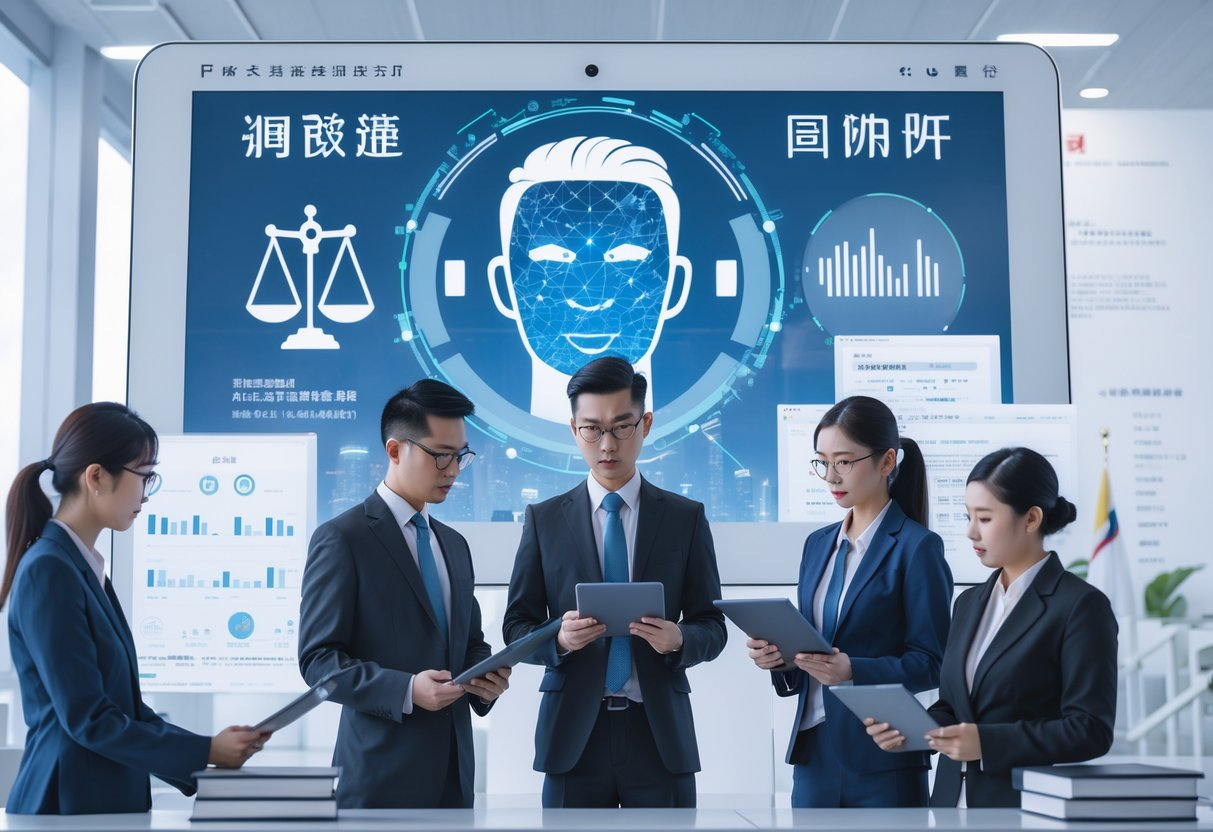Using Facial Recognition in China: What You Need to Know
Facial recognition in China is widely used by both government agencies and private companies for purposes ranging from convenience to security and social management.
As a global leader in this field, China relies on its extensive surveillance network to monitor citizens on a massive scale. In recent years, the government has introduced regulations to address privacy concerns, but these measures have clear limits, especially when it comes to state use of the technology.
China’s new regulations, rolling out in 2025, set clearer rules for how this tech gets used. The focus is on protecting personal data, boosting security, and keeping misuse in check.
But businesses and government agencies can still use facial recognition to stay efficient and keep control. This tech brings speed and safety, but it also sparks debate about privacy and trust.
Key Takeaways
- Facial recognition is everywhere in China’s daily life
- New regulations set stricter standards for its use
- Privacy and security worries still matter a lot
Overview of Facial Recognition Technology in China
China links facial recognition with AI, a huge camera network, and massive databases. People use it for security, business, and everyday things, while government rules try to balance efficiency and privacy.
Scope and Definition of Facial Recognition Technology
This technology works by analyzing facial features to identify or verify people. In China, it’s everywhere, powered by fast and accurate AI systems.
You might use it to unlock your phone, pay your bills, or enter your apartment building. It’s also common in transportation, retail, and banking.
Surveillance cameras feed data into big platforms that match faces to databases. This makes facial recognition a tool for both convenience and public safety.
China defines facial recognition broadly, covering any system that collects, stores, or processes facial data. That means private companies and public agencies all have to follow the rules.
Key Government Agencies and Regulatory Bodies
The Cyberspace Administration of China (CAC) manages data protection and sets standards for collecting and storing facial data. If you handle personal info, you have to follow their rules.
The Ministry of Public Security (MPS) uses facial recognition for law enforcement and national security. They run surveillance networks and work with local police to track crime and keep order.
Other agencies, like the Ministry of Industry and Information Technology, also set technical standards. Together, they create a broad regulatory system for security, privacy, and industry practices.
New rules say you can’t use facial recognition as the only way to verify identity if there’s another option. If your system processes data from over 100,000 people, you have to file with authorities.
Growth and Adoption Across Sectors
You’ll find facial recognition in all kinds of industries in China. Retailers use it for cashless payments, schools for attendance, and airports for faster boarding.
The public sector relies on it for surveillance and crowd management. Local governments use it in smart city projects to boost safety and efficiency.
Big Chinese tech companies like SenseTime and Hikvision develop much of this technology. They supply both China and international markets, keeping China ahead in the field.
Most people support facial recognition for security, according to surveys. Still, the government is rolling out new standards to address privacy concerns and prevent misuse.
Staying compliant is key for success. Read, Compliance in China's Tech Industry: A Guide for Foreign Investors to learn the essentials.
Legal Framework and Regulations

China uses detailed rules to control facial recognition, focusing on consent, security, and oversight. These rules set out how you collect, store, and use personal data, and require checks to protect people’s rights.
Recent Regulatory Measures and Implementation
On March 21, 2025, the Cyberspace Administration of China (CAC) and the Ministry of Public Security (MPS) issued the Measures for the Administration of the Security of the Application of Facial Recognition Technology. These rules start on June 1, 2025.
The measures cover organizations using facial recognition in public and private spaces but leave out research and algorithm training. They line up with other laws like the Cybersecurity Law, Data Security Law, and Personal Information Protection Law.
If you use facial recognition in places like residential buildings, public spaces, or businesses, you must follow strict requirements. Collecting face data without a good reason or in excess is not allowed. The government says use must be necessary, reasonable, and legal.
The CAC and MPS share supervision. They inspect, demand fixes, and hand out penalties for non-compliance. This dual oversight covers both cybersecurity and public safety.
Requirements for Data Storage and Processing
The new rules treat facial data as sensitive personal information. You have to protect it more than regular data.
Key steps include:
- Encrypting stored face data.
- Access controls to limit who can see or use the data.
- Retention limits so data isn’t kept longer than needed.
When possible, keep face data separate from other personal info. That way, if there’s a breach, there’s less risk of misuse.
Only process data for clear, limited reasons, like identity checks or security. Using it for things like targeted ads isn’t allowed unless people say yes.
To stay compliant, set up internal policies, train your staff, and audit your systems often. These steps show regulators you’re serious about protecting sensitive data.
Privacy Impact Assessment and Filing Obligations
Before you use facial recognition, you need to do a Privacy Impact Assessment (PIA). This checks if the tech is needed, what risks it brings, and what safeguards you have.
Your PIA should cover:
- What data you’ll collect
- Why you need to process it
- Security measures to prevent leaks
- Other options you looked at before picking facial recognition
After the PIA, you might have to file records with regulators, especially if you use the system in places like schools, hospitals, or big public venues. This lets authorities check your compliance and step in if needed.
If you skip this step, you could get fined, have your operations suspended, or face tougher oversight. Treating the PIA as routine helps you avoid trouble and build trust with users.
Alternative Verification Methods
The rules say facial recognition can’t be the only way to verify identity. You must give people other options so they can choose how to prove who they are.
Alternatives include:
- Password or PIN codes
- ID card checks
- Fingerprint or other biometrics
This means people aren’t forced to give face data if they don’t want to. For example, a building using facial recognition for entry must also allow access with a key card or code.
Offering choices means you’re not stuck with one system and helps everyone feel included. It also cuts the risk if the facial recognition system breaks or makes mistakes.
New rules are shaping the future of technology. To see what’s changing, read our article, China Deep Synthesis Regulation 2025: Essential Guide.
Privacy, Security, and Ethical Considerations

When you use facial recognition in China, the big concerns are how your data is collected, stored, and shared. People worry about their sensitive info getting leaked and how constant surveillance might change how they act in public.
Sensitive Personal Information and Facial Data Protection
Your face is unique, and once someone captures it, you can’t just change it like a password. In China, facial recognition systems often store this data in big, centralized databases.
This brings up questions about how safe your biometric info really is. China’s Personal Information Protection Law (PIPL) classifies facial data as sensitive personal information, so companies and agencies have to follow strict rules.
Providers must only collect what’s needed and get clear consent before using your data. But not everyone follows best practices—some skip encrypting their databases or let too many people have access.
Weak protections make misuse more likely, like sharing your data without asking or using it for something else.
Risks of Data Leaks and Public Security
Big facial image databases are tempting targets for hackers. If someone breaks in, your biometric data could be exposed for good, and you can’t just swap out your face for a new one.
China’s already seen some personal data leaks, raising doubts about how secure these systems really are. Poor network security, bad encryption, and insider misuse are common problems.
The government says facial recognition helps prevent crime and keep order. But if the data gets stolen, it could be used in harmful ways. Finding the right balance between safety and risk is tough.
Public Concerns and Behavioral Impact
It’s normal to feel uneasy knowing cameras can track you in public. This constant watch can change how you act, especially if you think your every move is recorded.
People in China have mixed feelings. Many like the convenience of quick payments and secure entry, but others worry about losing privacy.
When surveillance spreads into schools, offices, or homes, the impact gets stronger. Some folks may avoid certain places or change their habits—not because of laws, but because they don’t want to be watched. That shift is one of the biggest ethical debates around facial recognition in China.
Privacy laws affect both people and businesses. For a clear overview, check out our piece, China Privacy Law: What You Need to Know.
Applications and Limitations of Facial Recognition

In China, facial recognition is everywhere—from daily services to security and research. You’ll see it for ID checks, public monitoring, and tech development, but new rules now limit when and how it gets used.
Identity Verification in Public and Private Sectors
You run into facial recognition a lot—unlocking your phone, checking in at hotels, or walking into an office building. Businesses use it to speed things up and avoid manual checks.
Banks and payment systems rely on it too. You can confirm who you are fast, no need to pull out a card.
Since June 2025, you can’t be forced to use facial recognition if there’s another secure way. You should get options like ID cards or mobile codes.
This rule tries to stop forced use in places like gated neighborhoods or store checkouts.
The system is convenient, but now there are limits. Companies have to explain why they need facial recognition instead of something less intrusive.
This change means less personal data gets collected for no reason.
Use in Public Security and Surveillance
Authorities in China use facial recognition to watch over public spaces, train stations, and big events. You’ll spot it in airports, tracking crowds or flagging people on watchlists.
It helps prevent crime by matching faces with police databases. Sometimes it helps find missing people or confirm someone’s identity in emergencies.
New rules now limit how much it can be used. Operators have to follow strict security rules and protect the data they collect.
There’s more oversight on how surveillance footage gets stored and shared.
Exemptions for Research and Algorithm Training
Facial recognition matters in research too. Universities and companies use big datasets to train smarter algorithms.
Some regulations make room for this, as long as data protection standards are clear. Developers can work on recognition systems using anonymized or consent-based datasets.
This helps AI improve without crossing privacy lines. Still, there’s no free pass—researchers have to follow data security laws and avoid using sensitive data without permission.
Balancing innovation and protection is still a challenge.
Data protection is becoming more important than ever. To understand the safeguards, explore our guide, Chinese Data Protection Law: Upholding Data Privacy in China.
Bottom Line
The story of using facial recognition in China blends innovation with controversy. It delivers speed, convenience, and security, yet raises serious concerns over privacy and personal freedom.
With one of the world’s largest surveillance systems, China leads in applying this technology, while recent regulations attempt to balance progress with protection. Still, limits remain, especially with state use.
Handling data across borders comes with strict rules. To learn how they impact businesses, read our article, China Data Localization Laws for Foreign Companies.
👉 To understand how these rules may affect businesses, compliance, and society, consult China legal experts for clear, reliable guidance.
Frequently Asked Questions
What are the implications of facial recognition technology on privacy in China?
Since June 1, 2025, you get stricter data protection. Organizations have to explain why they want to use facial recognition, and can’t use it everywhere unless it’s needed for safety or management.
Your personal info is better protected under China’s Cybersecurity, Data Security, and Personal Information Protection Laws. But people still worry about surveillance and misuse.
How does China's social credit system integrate facial recognition technology?
Facial recognition connects to the social credit system. Cameras can spot people and link their actions—like breaking rules—to their records.
This lets authorities track who follows the rules and hand out rewards or penalties. Biometric data makes these systems more accurate, for better or worse.
What are the leading Chinese companies specializing in facial recognition technology?
You’ll see SenseTime, Megvii (Face++), Yitu Technology, and CloudWalk at the top. They build software and hardware for government agencies, banks, and stores.
They drive research and development, making China a big player in facial recognition tech.
In what ways is facial recognition technology used to enforce laws, such as detecting jaywalking in China?
Look at intersections—facial recognition cameras catch jaywalkers. The system snaps a photo, matches it to an ID, and sometimes flashes your name or picture on a public board.
It’s meant to discourage rule-breaking and push people to follow traffic laws.
How extensive is the network of facial recognition cameras throughout China?
China’s got one of the world’s biggest surveillance networks. There are hundreds of millions of cameras, many with facial recognition.
These cover public areas, transit hubs, neighborhoods, and offices. It’s possible to monitor and identify people in real time, almost anywhere in the city.
How does facial recognition technology support payment systems in China?
You can pay for things with just your face—no phone or card needed.
Lots of stores, metro stations, and restaurants use kiosks or terminals that scan your face for fast payments.
This tech links your face to digital wallets like Alipay or WeChat Pay.
It makes paying way quicker and honestly, a lot simpler.
Subscribe to receive updates
Subscribe to receive the latest blog posts to your inbox every week.



